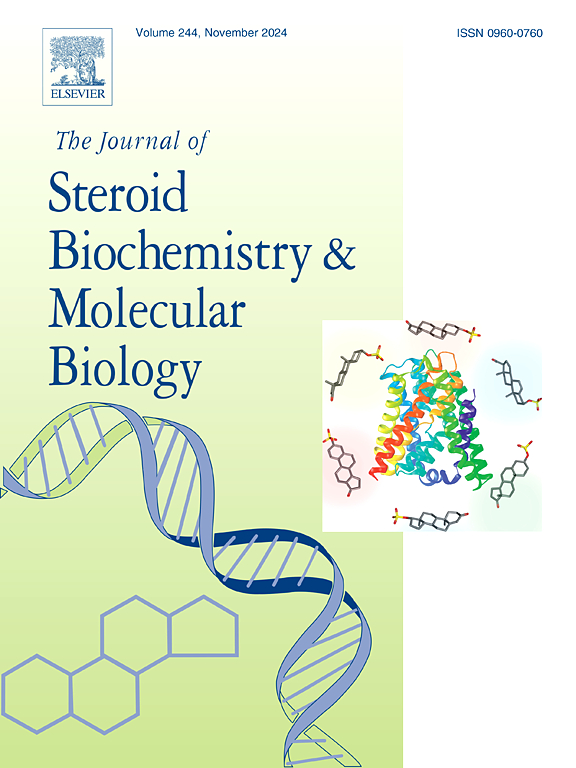Non-esterified fatty acids disrupt hepatic lipid metabolism and mitochondrial function via TLR4/MyD88/IRAK2 signaling in bovine hepatocytes
IF 2.5
2区 生物学
Q3 BIOCHEMISTRY & MOLECULAR BIOLOGY
Journal of Steroid Biochemistry and Molecular Biology
Pub Date : 2025-06-13
DOI:10.1016/j.jsbmb.2025.106813
引用次数: 0
Abstract
Excessive non-esterified fatty acids (NEFA) in the blood often lead to ketosis and fatty liver in peripartal cows. The integrity of mitochondrial structure and function plays a key role in the development of lipid metabolism imbalance and inflammation. However, the precise molecular mechanisms of NEFA's impact on these processes remain unclear. To explore how NEFA (0, 0.3, 0.6, 1.2, and 2.4 mM) influence lipid metabolism, inflammation, and mitochondrial function in perinatal cow hepatocytes. Bovine primary hepatocytes were isolated from five 1-day-old Holstein calves using collagenase IV perfusion, hepatocytes were treated with various concentrations of NEFA for 12 h to systematically simulate the metabolic changes in the negative energy balance (NEB) environment. Oxidative stress levels, lipid metabolism gene and protein expression, inflammatory pathway activation, and mitochondrial structure and function were assessed. Compared with the control group, 1.2 and 2.4 mM NEFA significantly increased lipid accumulation (TAG, T-CHO, LDL-c) and oxidative stress (MDA), while reducing antioxidant levels (GSH, SOD, T-AOC). NEFA upregulated lipogenic genes (SREBP-1c, ACC, FASN) and downregulated lipid oxidation genes (PPARα, CPT1A). Lipid transport was impaired, with altered APOE, LDLR, CD36, and L-FABP expression. NEFA activated the TLR4/MyD88/IRAK2/NF-κB pathway, increasing pro-inflammatory cytokines (IL-1β, IL-6, TNF-α). Mitochondrial function was impaired, as evidenced by increased ROS, reduced mitochondrial membrane potential, decreased mtDNA levels, and downregulated expression of oxidative phosphorylation genes. NEFA enhanced IRAK2 mitochondrial translocation, inhibited the mitochondrial biogenesis process, and increased apoptosis. NEFA alters lipid metabolism, inflammation, and mitochondrial function in bovine hepatocytes via the TLR4/MyD88/IRAK2 pathway, providing a new target for preventing metabolic diseases in perinatal cows.
非酯化脂肪酸通过TLR4/MyD88/IRAK2信号通路破坏牛肝细胞的脂质代谢和线粒体功能。
血液中过量的非酯化脂肪酸(NEFA)经常导致奶牛的酮症和脂肪肝。线粒体结构和功能的完整性在脂质代谢失衡和炎症的发生中起着关键作用。然而,NEFA影响这些过程的确切分子机制尚不清楚。探讨NEFA(0、0.3、0.6、1.2和2.4mM)对围产期奶牛肝细胞脂质代谢、炎症和线粒体功能的影响。采用胶原酶IV灌注法分离5头1日龄荷斯坦犊牛原代肝细胞,用不同浓度的NEFA处理肝细胞12h,系统模拟负能量平衡(NEB)环境下的代谢变化。评估氧化应激水平、脂质代谢基因和蛋白表达、炎症通路激活以及线粒体结构和功能。与对照组相比,1.2和2.4mM NEFA显著增加脂质积累(TAG、T-CHO、LDL-c)和氧化应激(MDA),同时降低抗氧化剂水平(GSH、SOD、T-AOC)。NEFA上调脂质生成基因(SREBP-1c、ACC、FASN),下调脂质氧化基因(PPARα、CPT1A)。脂质转运受损,APOE、LDLR、CD36和L-FABP表达改变。NEFA激活TLR4/MyD88/IRAK2/NF-κB通路,增加促炎因子(IL-1β、IL-6、TNF-α)。线粒体功能受损,表现为ROS升高、线粒体膜电位降低、mtDNA水平降低、氧化磷酸化基因表达下调。NEFA增强IRAK2线粒体易位,抑制线粒体生物发生过程,增加细胞凋亡。NEFA通过TLR4/MyD88/IRAK2通路改变牛肝细胞的脂质代谢、炎症和线粒体功能,为预防围产期奶牛代谢疾病提供了新的靶点。
本文章由计算机程序翻译,如有差异,请以英文原文为准。
求助全文
约1分钟内获得全文
求助全文
来源期刊
CiteScore
8.60
自引率
2.40%
发文量
113
审稿时长
46 days
期刊介绍:
The Journal of Steroid Biochemistry and Molecular Biology is devoted to new experimental and theoretical developments in areas related to steroids including vitamin D, lipids and their metabolomics. The Journal publishes a variety of contributions, including original articles, general and focused reviews, and rapid communications (brief articles of particular interest and clear novelty). Selected cutting-edge topics will be addressed in Special Issues managed by Guest Editors. Special Issues will contain both commissioned reviews and original research papers to provide comprehensive coverage of specific topics, and all submissions will undergo rigorous peer-review prior to publication.

 求助内容:
求助内容: 应助结果提醒方式:
应助结果提醒方式:


